https://coinweek.com/ancient-coins/coinweek-ancient-coin-series-the-ptolemies-part-iii/
CoinWeek Ancient Coin Series: The Ptolemies, Part III

CoinWeek Ancient Coin Series by Mike Markowitz …..
THE TRAGIC AND CHAOTIC last generations of the Ptolemaic Kingdom of Egypt were dominated by the growing power of Rome, and the fickle loyalties of Alexandria's unruly population (usually described by historians as "the mob"). A lack of ancient statistics makes numerical estimates risky[1], but the consensus is that Alexandria in this era had as many as half a million inhabitants. Coinage of this period has a special fascination for collectors of ancients largely because of the glamorous and dramatic figure of Queen Cleopatra VII.
Ptolemy IX Soter II "Lathyros" (116 – 107, 88 – 80 BCE)
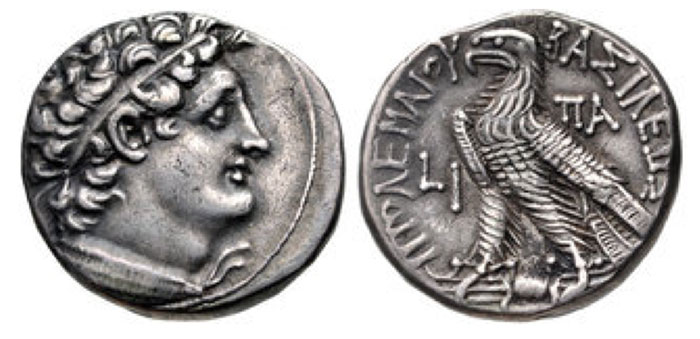
Ptolemy VIII had two sons by his wife (who was also his niece and step-daughter), Cleopatra III. When he died in 116 BCE, she became regent for the boys, both named Ptolemy. No one found this confusing, because they were called by different "epithets" or nicknames. The elder, aged about 27, was known as Lathyros, which means "chickpea" in Greek (the reason for this nickname baffles historians). When he came to the throne, he adopted the epithet Soter ("savior", which had already been used by the founder of the dynasty, so he is known as Ptolemy IX Soter II). The younger, about 24, was known as Alexander. There are, as far as we know, no portrait coins of these two brothers, who spent decades trying to overthrow one another.
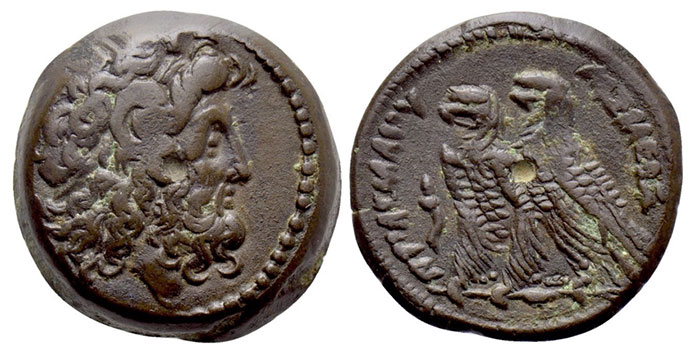
Their rather monotonous coinage consisted of tetradrachms in increasingly debased silver alloy with a stylized image of Ptolemy I on the obverse and the emblematic standing eagle on the reverse. The coins are dated in the reverse field with the symbol "L" meaning "year" and Greek numerals for the year of the reign. The letters ΠΑ served as the mintmark for Alexandria and (confusingly) also for Paphos on Cyprus. The inscription is always "King Ptolemy", but differences in style have allowed generations of numismatists to sort out which coins go with which king and the attributions made by Svoronos in the early 20th century have generally stood the test of time.
Ptolemy X Alexander (110 – 109, 107 – 88 BCE)
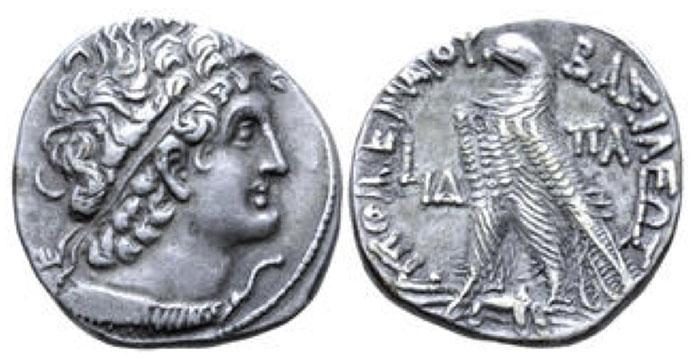
Ptolemy X Alexander initially ruled together with his mother, Cleopatra III. Deposed and exiled, he returned to power in 107. In 101, he had his mother killed, and then ruled with his wife (who was also his niece), Berenice III. When the people of Alexandria and the army turned against him in 88 BCE, he fled to Syria and raised a mercenary army. To pay these troops, he melted down the solid gold sarcophagus of his namesake, Alexander the Great, replacing it with one of glass (some sources say rock crystal). The exasperated Alexandrians drove him out again, and he was killed in a sea battle while attempting to cross over to Cyprus.
Ptolemy XII Neos Dionysos "Auletes" (80 – 58, 55 – 51 BCE)
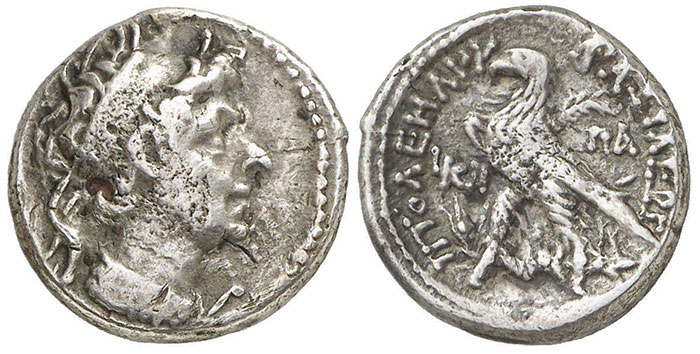
When Ptolemy IX Lathryos died in 80 BCE, aged about 62, he was briefly succeeded on the throne by his daughter, Berenice III, "who was much beloved by the Alexandrines" (Bevan, 342). Because tradition insisted on a male co-ruler, she chose an illegitimate son of her uncle, who became "Ptolemy XI Alexander II". This proved to be a poor choice; after about six months, he murdered her. The mob invaded the palace and tore him to pieces. At this point, the only available royal was another illegitimate son, quickly installed as Ptolemy XII, taking the Greek epithet Neos Dionysos ("the New Dionysus", after the god of wine and ecstasy.) He is better known for his musical talent as Auletes ("flute player").
Proficiency in flute-playing may go with serious interests, as it did in the case of Frederick the Great, but in Ptolemy XII the serious interests seem to have been lacking, and the regular accompaniments of flute-playing in ancient days were justly held discreditable in a king (Bevan, 351).
There is a rare portrait coin of Auletes: a silver drachm issued at Paphos[2]. The engraver shows him with a sharp nose, but there is a clear resemblance to his Ptolemaic ancestors. Most of Auletes' Alexandria coinage carries the familiar image of Ptolemy I, but the workmanship is poor and the metal was increasingly debased (down to about 80% silver).
The Roman Senate initially refused to recognize Auletes as ruler of Egypt. In 58 BCE, Auletes traveled to Rome, borrowed funds for an enormous bribe of 6,000 talents[3] to secure Julius Caesar's support, and was declared a "Friend and Ally of the Roman People".
Auletes produced at least three daughters and two sons by at least two uncertain wives. His eldest daughter, Berenice IV, seized power in her father's absence. Pressured to marry a Seleucid prince as a male co-ruler, she soon grew tired of him and had him strangled. In 55 BCE, Auletes returned to Alexandria with the help of Roman troops and Berenice was beheaded.
Ptolemy XIII Theos Philopator (51? – 47 BCE)
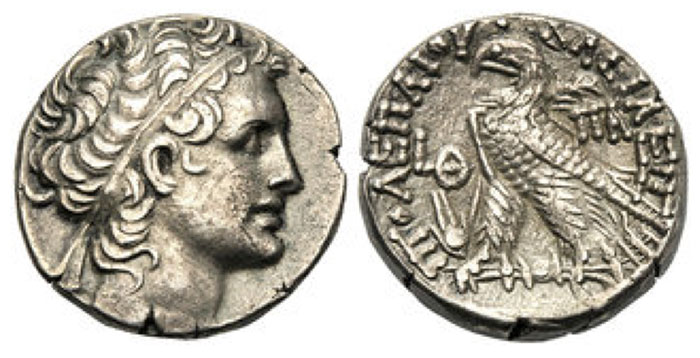
When Auletes died in 51 BCE the political situation became chaotic. In theory, his 11-year-old eldest son took the throne, symbolically "married" to his half-sister Cleopatra VII, aged about 17. His epithet was Theos Philopator ("the god beloved of his father"). In reality, the army commander, the young king's tutor, and a powerful palace eunuch named Pothinus, were in control. Coins were issued, as usual, in the name of "King Ptolemy" with the stylized image of Ptolemy I on the obverse, but the regnal year of the current ruler in Greek numerals in the field of the reverse. Coins of Ptolemy XIII are relatively common; an example from Year 9 (c. 72 BCE) brought $382 USD in a 2015 auction[4].
Cleopatra VII Thea Neotera (51 – 30 BCE)

The independent city-state of Ascalon on the coast of Palestine was never part of Cleopatra's realm, but she must have charmed the residents, or done them some favor, because they issued silver tetradrachms with a magnificent portrait of the young queen (c. 50-49 BCE). On Harlan Berk's list of the 100 greatest ancient coins, this rare type is #30 (Berk, 74). Less than 10 examples are known. The last one to appear at auction in 2017 brought over $87,000[5]!
Arguably the most famous woman of classical antiquity, Cleopatra VII was born about 69 BCE. We do not know who her mother was, and the number "VII" may be in error (the identity of Cleopatra VI is uncertain, and may be a double-counting of Cleopatra V). With the help of Caesar's legions, Cleopatra defeated her brother, who was drowned in the Nile. Another spare younger brother, aged about 12, was duly installed as ceremonial male co-ruler "Ptolemy XIV Theos Philopator II".
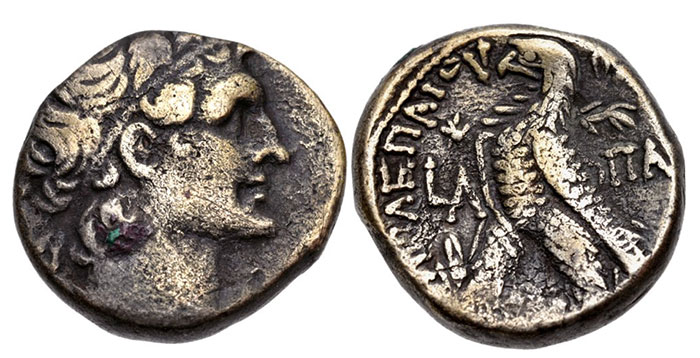
On June 23, 47 BCE, Cleopatra gave birth to Julius Caesar's son, Ptolemy XV, known by the epithet "Caesarion". Rare coins dated Year 1 of Caesarion were issued in 37 BCE to mark the boy's elevation to co-ruler with his mother[6].
Cleopatra's bronze coinage was a significant currency reform. Her portrait appears on the obverse, and her name and title (KΛEOΠATPAΣ BAΣIΛIΣΣHΣ, "of Queen Kleopatra") are inscribed around an eagle on the reverse. There were two main types: a large "diobol" of about 21 grams, denominated as 80 bronze drachms and marked with the Greek numeral for 80 (Π); and a smaller "obol" of about nine grams, marked with "M" for 40.
Because so many collectors want to own a coin of Cleopatra, these types command very strong prices. Long after Cleopatra's death, they remained in circulation; surviving examples are often quite worn. In the past, many of these coins were tooled to "improve" the details of the portrait, so truly pristine examples go for much higher prices. A superb diobol brought over $10,000 in a 2013 auction[7], and in 2010 a choice obol went for $3,500 against an estimate of $1,000[8].
Mark Antony issued some historically important and highly collectible coins bearing Cleopatra's portrait, but these will not be considered here since they were Roman rather than Ptolemaic Egyptian.
To avoid being paraded through Rome in Octavian's triumph, Cleopatra killed herself on August 10 or 12, 30 BCE.
The final scene of Shakespeare's play Antony and Cleopatra repeats the ancient writer Plutarch's account, in which a Roman officer bursts into the room where Cleopatra has just died to demand of her handmaid Charmian, "Is this well done?":
It is well done, and fitting for a princess
Descended of so many royal kings.
–Act V, scene ii
Ptolemy of Mauritania: The Last Ptolemy (24 – 40 CE)
Cleopatra VII's surviving daughter by Mark Antony, Cleopatra Selene, married Juba II (reigned 30 BCE – 23 CE), the Roman client king of Mauritania[9]. Their son, Ptolemy of Mauritania, struck coins on the Roman denarius standard, with his portrait and his name and title inscribed in Latin[10]. In 40 CE he was summoned to Rome by his cousin, the emperor Caligula, and murdered–apparently because he wore a gold-embroidered purple cloak more splendid than Bootsie's[11].
With the death of Cleopatra's grandson, the dynasty of the Ptolemies came to an end.
* * *
Notes
[1] Few ancient papyrus documents survive from Alexandria due to the humid climate and frequent civil unrest – the existing paper trail mainly reflects life in Upper Egypt.
[2] Gorny and Mosch, Auction 232, 5 October 2015, Lot 316. Realized $3,364 USD.
[3] Various weights were used for the silver talent in antiquity. The Romans reckoned a talent at roughly 33 kg (73 pounds).
[4] Bertolami Auction 16, 17 June 2015, Lot 301.
[5] Roma Numismatics, Auction XIII, 23 March 2017, Lot 428. Realized $87,686 USD.
[6] Classical Numismatic Group (CNG) Sale 84, 5 May 2010, Lot 770. Realized $1,400 USD.
[7] Roma Numismatics, Auction 6, 29 September 2013, Lot 682. Realized $10,479 USD.
[8] CNG Triton XIII, 5 January 2010, Lot 240.
[9] In western North Africa; the capital was Caesarea, now Cherchell, 55 miles (89 km) west of Algiers.
[10] Marti Hervera, Soler & Llach Auction 107, 18 May 2012, Lot 2406. Realized approx. $165 USD.
[11] The nickname "Caligula" literally means "Little Boots".
References
Berk, Harlan J. 100 Greatest Ancient Coins. Atlanta (2008).
Bevan, Edwyn R. The House of Ptolemy. London (1927).
Brett, Agnes Baldwin. "A New Cleopatra Tetradrachm of Ascalon", American Journal of Archaeology 41 (1937).
Faucher, Thomas and Catharine Lorber. "Bronze Coinage of Ptolemaic Egypt in the Second Century BC", American Journal of Numismatics 22 (2011).
Fletcher, Joann. The Story of Egypt: The Civilization that Shaped the World. New York (2016).
Hazzard, Richard A. Ptolemaic Coins: An Introduction for Collectors. Toronto (1995).
— and I. D. Brown. "The Silver Standard of the Ptolemaic Coinage", Revue Numismatique 26 (1984).
Newell, Edward. Royal Greek Portrait Coins. New York (1937).
Pollard, Justin and Howard Reid. The Rise and Fall of Alexandria: Birthplace of the Modern Mind. New York (2006).
Preston, Diana. Cleopatra and Antony. New York (2009).
Roller, Duane. Cleopatra: A Biography. Oxford (2010).
Shakespeare, William. Antony and Cleopatra. (c. 1607).
Siani-Davies, Mary. "Ptolemy XII Auletes and the Romans", Historia 46 (1997).
Svoronos, Ioannis. Ta nomísmata tou krátous tōn Ptolemaíōn (Coinage of the Ptolemaic Rulers), 4 volumes. Athens (1904-08).
Wilkinson, Toby. The Rise and Fall of Ancient Egypt. New York (2010).
-- Sent from my Linux system.
No comments:
Post a Comment